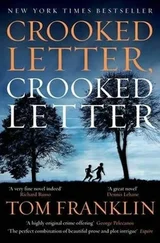eighteen
Angie drives Silas home from the hospital. He drops in at City Hall where the mayor tells him he will be getting a new car and some assistance in his work, apparently to be financed by Tina Rutherford’s father. Silas tells the mayor to wait until he sees the story coming out in the local paper before he authorises any of this.
He then goes home to convalesce. He visits Larry, who refuses to talk to him. He also goes to visit Mrs Ott in the nursing home, but she doesn’t know who he is, lost in dementia. He goes to look at the derelict Walker house.
nineteen
Four days later: Silas has visited Larry every day, but while he enjoys the visits, Larry doesn’t know how to react or what to say. Silas has been taking care of things for him, feeding the chickens, bringing him his mail and his cheque book so he can pay his bills.
The doctor tells Larry he can start moving around now, but that he must start eating a healthier diet. Larry takes short walks around the hospital, noticing all the reporters outside waiting for him. Late that night he sneaks out of the hospital. He starts to walk home.
Silas gets a phone call from the hospital telling him that Larry has left, and he immediately gets in his car and heads off to find him. He discovers Larry walking home. Silas drives him home, and Larry offers to fix up Silas’ jeep.
Larry is surprised that Silas and Angie have cleaned up his house while he was in hospital. Larry says Silas should come by the next day so they can work on the Jeep. Their friendship appears to be restored.
SUMMARY
Crooked Letter, Crooked Letter is structured as a crime thriller: a crime occurs early in the narrative and the plot involves solving the crime. The novel is also concerned with events in the past, and so it is structured to include long passages of flashbacks to 25 years ago. Other structural elements which organise the plot and the characters include the use of symmetry to highlight both divisions and similarities. Here we will also look at the evolution of the friendship between Larry and Wallace as an organising structure in the novel.
The title
The concept of place – the idea of where you are, where you belong – and the actual physical location are important in the novel. Alice and Silas’ transition from the northern city of Chicago (the third largest city in the USA) to this tiny hamlet in rural Mississippiis a big deal: For the 13-year old Silas it’s a completely different world. The racial and social tensions and dynamics of rural Mississippi are not the same as in Chicago, a major northern city. And for Larry Ott, his notoriety as “Scary Larry” is greatly exacerbated by his location in a tiny communitywhere everyone knows everyone else – a community he has never really left, with the exception of his short time in the military.
This idea of the central importance of placein the novel begins with the title. Taken from a children’s rhyme used as a mnemonic for the correct spelling of Mississippi (the crooked letter meaning the letter “s”), the title Crooked Letter immediately and firmly anchors the novel and our expectations in a specific place, namely the deep South, and gives it a specific frame of reference: Childhood.
The idea of belonging is a central theme in the novel, and the characters belong to this specific place in varying degrees. We have Larry, who has never left and is tied to a place where he is now a pariah, and Silas, who was conceived here, but who grew up far to the north before being brought back as a teenager, only to leave again, and return yet again as an adult. Alice’s inability to successfully leave this specific place behind her is an important device within the plot of the novel, a device which is used to bring Silas into the story, and to expose the secrets within Carl Ott’s past. The place, Chabot in Mississippi, won’t let people go: Larry can’t escape. Alice can’t escape. And Silas is dragged back twice, also unable to escape.
Chronology

The novel is concerned with the connected events of two different times– the year 1982 and the present day (presumably 2007, 25 years later). The narrative makes strong use of flashbacks, at times with entire chapters being set in the past (Chapters 3, 5 and 7) but also in shorter forms, with the central characters Larry and Silas remembering momentsfrom their past and the events which drove them apart.
The extensive use of flashbacks means that the structure of the novel must be considered in two different ways. Firstly, there is the surface structure, the sequence of chapters and narrative, which moves back and forth in time and follows the demands of the plot and the creation and release of tension and suspense. Then there is the internal chronology, the actual sequence of events within the lives of the characters in the novel, beginning with the first meeting between Larry and Silas in March 1979. (There is of course another, older part of the story – the affair between Alice Jones and Carl Ott – which is only reconstructed after both have died, and which can be understood by the reader as a kind of lost or hidden prologue to the story.)
The frequent use of flashbacks not only means that the novel has two structures: It also means that events in the past are looked at from two perspectives, those of childhood and adulthood. Major events – such as Silas’s first and only visit to Larry’s home when they were boys – are approached carefully, in stages. When Silas goes to investigate the Ott farm after Larry’s shooting (pp. 85–95) there are brief mentions of his having been there before, and a lengthier description (pp. 87.20–88.10) of Silas’ recollections of that day. This event is seen later, in greater detail and with more emotional reflection, from the boys’ perspectives.
We see events from one chronological perspective – adult or child – and then from another. This is significant, because many of the greatest conflicts in the novel – in particular the guilt Larry feels for having called Silas “n****r” and the guilt Silas feels for having betrayed Larry by not speaking up about Cindy Walker – are hidden in the past, but have enormous consequences throughout the two men’s lives. One target the novel moves towards is the possible reconciliation between Larry and Silas, which requires both of them to re-evaluate events from 25 years ago, to reflect on the feelings and impressions from the time and to consider their changed circumstances and the different perspectivesthey now have as adults.
An example of how the two time frames interact
As an example of how the two time frames interact, we can look at the end of Chapter 4, the content of Chapter 5 and the beginning of Chapter 6. Chapter 4 is set in the present day and ends with Silas in his own home, having returned from investigating the crime scene at Larry’s home. Two things are important here at the end of the chapter. Most obviously significant is the message from Larry on Silas’ answer machine, a phone call made before he was shot. The second is less explicit but equally important: “In the closet, behind his two extra uniforms, where he wouldn’t have to look at it, was the Marlin lever-action .22 rifle.” (p. 96.21–23)
The chapter which follows is about the significance of this small detail. It describes the events leading up to the scene where Carl Ott forces Larry and Silas to fight for possession of the gun, the .22 Marlin. While it is Silas’ memory which is triggered in the present, we see this episode from the past from Larry’s perspective. The scene is of central importancefor the entire book and for many of the themes – brothers, fathers and friends; guilt; race – and it is the single most important event in the course of Larry and Silas’ relationship. The chapter from the past is therefore introduced and given context by a guilty memory of Silas’ in the present day. This detour into the past is touched on again at the beginning of the next chapter when Silas acknowledges to himself that he used the event – Larry calling him “n****r” – as an excuse to avoid him (p. 121.11–13). The rifle also makes another appearance (p. 125.8–10). What we as readers don’t know yet is that this level of guilt and angercovers a much deeper and much more damaging guilt – Silas’ guilt at never having spoken up to save Larry from the suspicions surrounding Cindy Walker’s disappearance.
Читать дальше













